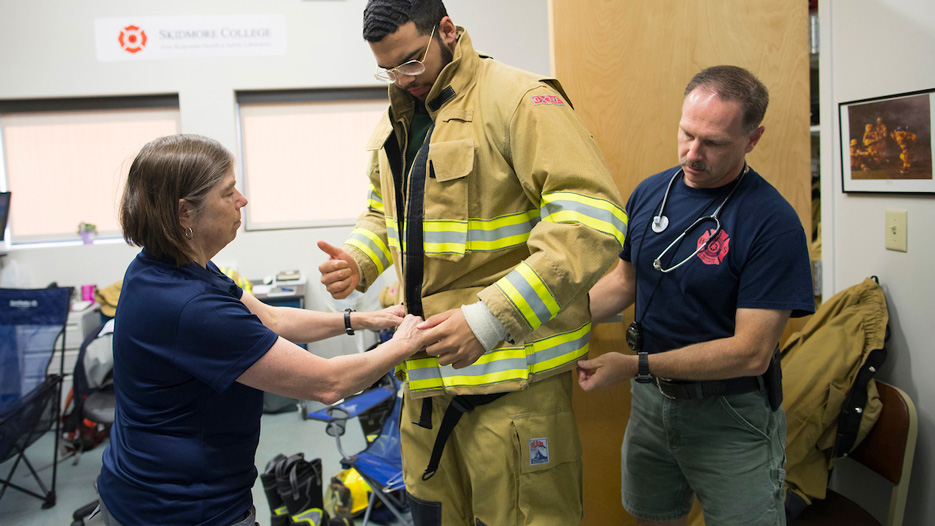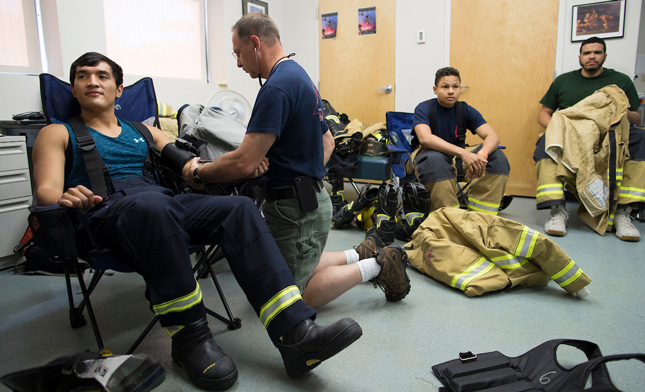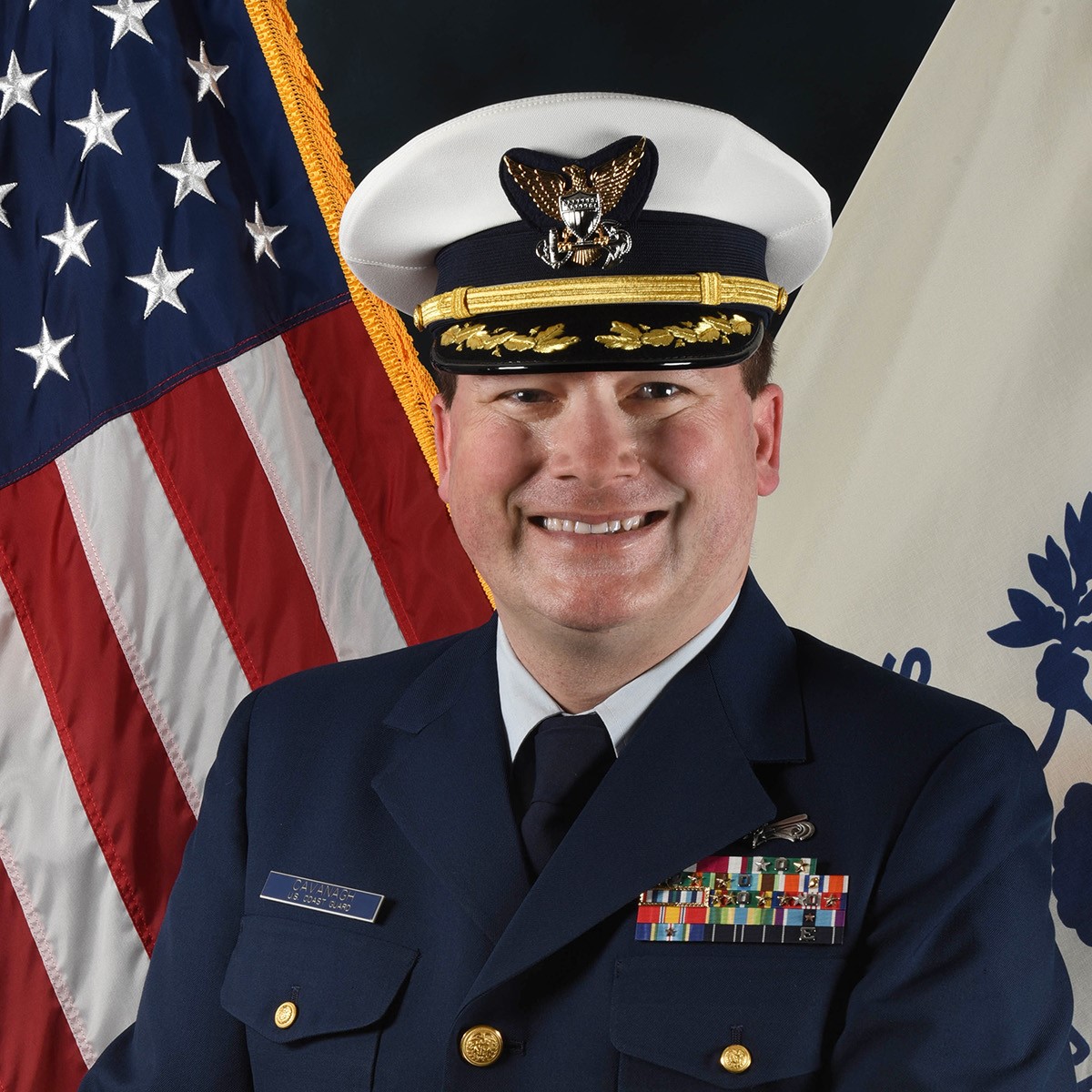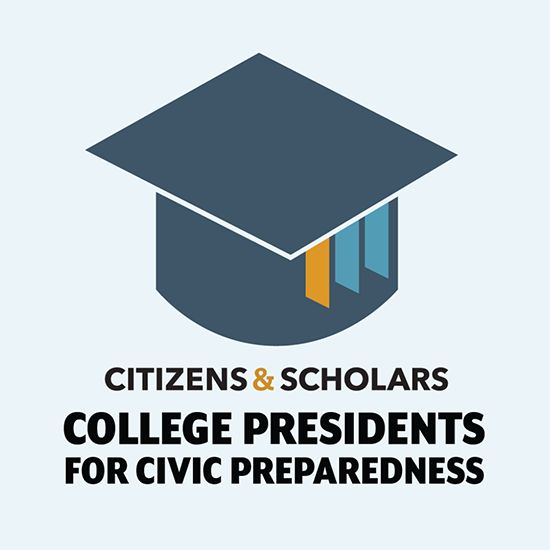First responder research saves lives

Cassie Eddy ’17 graduated from Skidmore last spring, and in the fall she starts a master’s in health informatics at the University of Michigan. This past year, she worked full-time in Skidmore’s First Responder Health and Safety Lab, which is directed by Professor of Health and Human Physiological Sciences Denise Smith.
While many of Eddy’s days are filled with data collection and spreadsheets, Monday, June 11 was not one of those days. That morning at 9 a.m., she was wearing 30+ pounds of fire gear and simulating on-scene firefighter tasks in high heat and humidity.
Says Eddy, “It was like doing moderate yard work on a warm summer day with the added stressors of extra weight and clothing that inhibits the body's ability to cool. It was interesting to be a subject of research and definitely eye-opening to wear actual fire gear.”
For the past 18 months, Skidmore’s First Responder research team has partnered with the Hanover Park, Illinois, Fire Department, US Army Institute of Environmental Medicine, University of Illinois Fire Service Institute and UCLA on a $1.5 million FEMA grant project. It’s Skidmore's fifth such grant and brings the overall total to $5.4 million.
As part of the SMARTER project, all 52 Hanover Park firefighter/paramedics wore wireless, wearable technologies (specially designed shirts containing electronic modules) to sense, track and relay individual physiological responses during each 24-hour shift.
SMARTER, slated to conclude by year’s end, stands for Science, Medicine, Research, Technology for Emergency Responders.
A recognized fire service leader, Hanover Park has not only sent its data to Skidmore for ongoing analysis, but also has been able to observe and monitor information during incidents.
In fact, during a wildland brush fire call at a forest preserve last February, one firefighter was found to have an excessively high core temperature.
Skidmore’s Andrea Wilkinson, project manager for the SMARTER study, was in Hanover Park on this day, riding to calls with the on-duty shift commander. During the brush fire, she was watching live-feed data while the shift commander directed operations.
Wilkinson discovered and pointed out to the command staff that the firefighter’s core temperature had risen to an alarming 103 degrees. 104 is the diagnostic level for heat stroke and a 105 is associated with the beginning of brain-cell loss, says Haigh, adding that firefighters’ temperatures usually continue to rise even after ceasing strenuous activity due to an accumulation of internal heat.
“This was the first time our department has ever been able to track firefighter physiological responses in real time,” says Haigh. “And perhaps one of the first times anywhere.”

The gear firefighters wear typically weighs 30 to 50 pounds, while the tools and equipment they may carry at any given time can add 25 or more pounds.
More than half of firefighters' line-of-duty deaths in the US are caused not by dangers like flames or building collapses, but from cardiovascular reactions to the physical stress of the job—resulting in high levels of cardiovascular strain that can trigger a cardiovascular event in individuals with cardiovascular disease.
Says Smith, “The Hanover Park Fire Department was able to see the thermal strain in real time, and a firefighter was subsequently sent to rehabilitation (rest), a relatively new development in the fire service. Based on the event data and Chief Haigh’s extensive experience, he again explored his longheld idea of using different gear for non-structural fire incidents. We talked on the phone to discuss his findings and developing hypothesis, and we agreed to do a follow-up study to investigate the use of lighter-weight gear.”
Their pilot project name: “Comparing Thermal Strain of Structural Firefighting Gear to Novel Hybrid Gear.”
This past week, Haigh and three Hanover Park firefighter/paramedics, Ethan Gibbons, Justin McWilliams and Bernie Nevarez, traveled to Skidmore to participate in tests conducted in the college’s First Responder Lab.
In addition to Eddy, two other Skidmore graduates, Alex Matias ’18 and Marcus Jackson ’18, were tested, along with five New York-based firefighters from the Vischer Ferry Fire District, Clifton Park Fire Department and West Crescent Fire Rescue.
In the lab’s environmental chamber, set at 86 degrees and 50 percent humidity, the test subjects first wore structural fire gear during one trial and then later lighter-weight, non-structural fire gear in another trial.
Participants were tested doing a circuit designed to simulate a wildland fire: walking (to fire line), raking ground to form fire break, and water-pumping to simulate extinguishment. All activities were completed in both sets of gear and the physiological responses (core temperature, heart rate, ECG) monitored before, during and after the tests and later analyzed.
Matias, who is working in Smith’s lab doing data entry analysis, and previously has done two “tours of duty” in Skidmore’s summer collaborative research program, says the simulation experience helps him appreciate the firefighting occupation more: “They prioritize our safety, but we don’t prioritize theirs as much as we should. It feels good to be part of helping their cause.” Matias, who calls Ossining, New York, home, ultimately plans to pursue a doctorate in some aspect of physiology.
Smith has investigated personal protective equipment and related physiological burdens for 25 years, beginning in 1991 when she first assisted the Illinois Fire Service Institute shortly after arriving at Skidmore.
Smith and Haigh have collaborated on research on fire and health safety issues for the past 20 years. This latest project is a pilot study and the data has not been fully analyzed. However, there is emerging evidence suggesting that lighter-weight gear can reduce thermal strain, according to Smith.
Read more on Smith and her award-winning research.
Haigh appreciates the fact that Smith and her team are still crunching the numbers and that they will not deliver a final report until they are 100 percent certain of their findings.
But based on the “preponderance of the evidence,” he has requested $111,000 to equip his firefighters with hybrid gear that should provide flash, abrasion and blood-borne pathogen protection and be worn for all calls not requiring thermal protection, while keeping core temperatures in the safe range.
“The preliminary Skidmore test numbers reinforce our own data,” he says.
These non-structural events, including vehicle accidents, alarm investigations and some medical calls, as well as wildland fires, account for 87 percent of the department’s total call volume.
Smith is gratified that the work of her Skidmore team prepares students for graduate school and professional life, but most importantly, that it serves the public good: “My hope is that the science from our national studies and others continues to inform departmental policies and procedures to improve the health and safety of firefighters.”



 From faculty research to student stories, there's always something creative happening.
From faculty research to student stories, there's always something creative happening.